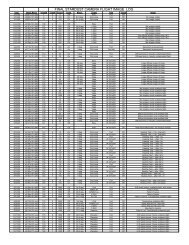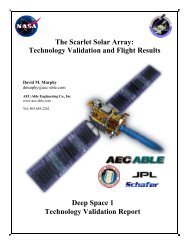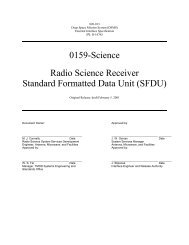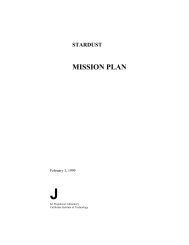PDS_VERSION_ID= PDS3 - PDS Small Bodies Node
PDS_VERSION_ID= PDS3 - PDS Small Bodies Node
PDS_VERSION_ID= PDS3 - PDS Small Bodies Node
You also want an ePaper? Increase the reach of your titles
YUMPU automatically turns print PDFs into web optimized ePapers that Google loves.
1.2.1.2 AO Data:<br />
IRAS devoted almost 40% of its observing time to Additional Observations (AO),<br />
that is, pointed observations of selected fields of interest. Comet Tempel 1 was<br />
the target of several frames of AOs. The duration of an AO is usually less than<br />
800 seconds. Motion compensation may not be necessary if the comet’s apparent<br />
motion is sufficiently small. Russell Walker used IPAC’s HIRES package to build<br />
the AO image. HIRES include an iterative process, the MCM algorithm, which was<br />
iterated 20 times. Maps were produced at the 1 st , 5 th , 10 th and 20 th iterations but only<br />
the 1 st and 20 th iterations are archived<br />
Image Data:<br />
The delivered AO images include radiance and noise images at the 1 st and 20 th<br />
iteration. The image is 241 x 241 pixels (NAXIS1 x NAXIS2). The coordinate<br />
system is equatorial. The comet is not centered in the image. The pixel size is 15 x<br />
15 arcsec.<br />
Photometry Data:<br />
The radiance (and noise) photometry files are the result of summing the radiance<br />
(and variance) from all the pixels that are within a selected distance from the pixel<br />
of maximum comet radiance. There are three columns in the files. The first is the<br />
distance (radius) that includes the pixels summed. Zero is the central pixel, etc.<br />
The second column is the summed radiance (or noise) in units of Watts cm -2 .<br />
The third column is the number of pixels actually included in the sum. Most of the<br />
coma flux should be contained within a few pixels radius. There is 0.846125 x<br />
10 -8 steradian per 15” square pixel.<br />
1.2.2 Index Elements<br />
The index elements of the archive exist as ASCII summary tables. The index file carries<br />
information about the scientific parameters for each data file such as the wavelength of<br />
the observation or some geometry information. The static data volume contains one index<br />
file for the images and photometry tables on the volume.<br />
The index elements can be loaded into a catalog system for use in image search and<br />
retrieval applications. The table is organized as a flat file; each row is an image or a table<br />
entry, and each column contains an attribute of the image or the table.<br />
1.2.3 Documentation Elements (including Trail Images)<br />
Documentation, stored as computer readable files, is an important supplement to the<br />
archive, preserving the knowledge of the mission after operations have concluded. The<br />
documentation includes mission, spacecraft, and instrument descriptions; literature<br />
references; and descriptions of the data products and archive contents. The<br />
documentation focuses on description of aspects of the archival data that are not<br />
published in technical journals and are not available through standard published<br />
literature. The documentation files are stored in both the document and the catalog<br />
directories, which is in the static data volume that accompanies the RDR image archive.






